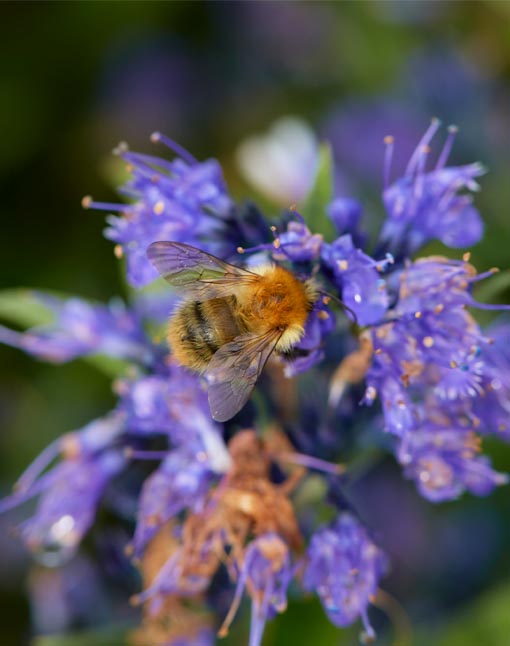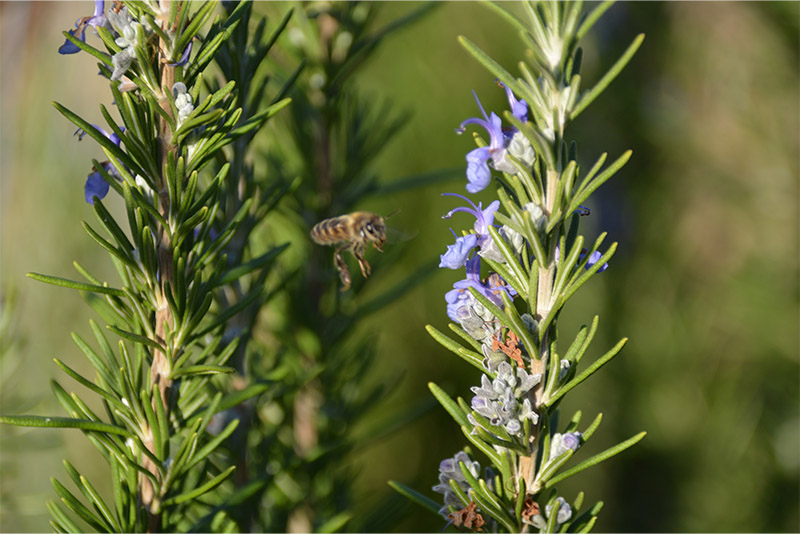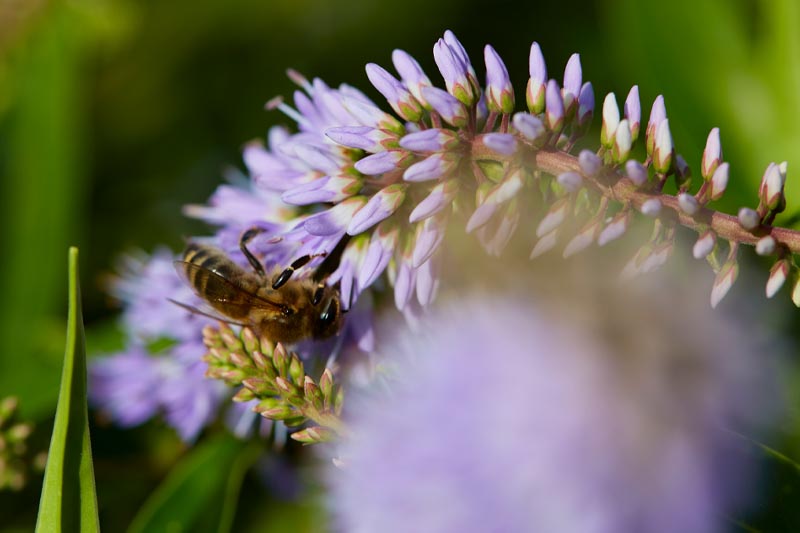Plants to Attract Bees
Tailor your landscape to support our bees

Caryopteris x clandonensis
Our beloved bees are one of the most important insects to humans on Earth, and they are currently facing huge threats for a variety of reasons, including habitat loss, climate change, a reduction in plant variety and pesticide use. Playing a part in every aspect of the ecosystem, we would truly suffer without bees; it’s vital for us to protect them and help them to thrive by providing correct nutrients and habitats, which allow for growth and reproduction.
In order to survive, bees require food, shelter and water. Food is broken down into nectar and pollen; nectar is carbohydrate rich and gives bees the energy to fly and search for their nest, and bee larvae feed on pollen, which is high in protein and needed for growth. Different bee species are active at different months of the year, so landscape designs should cater for bees by including plants which flower at various points, allowing for plenty of nectar and pollen all year round.
To provide bees with shelter, lawns can be left to grow longer between mowing; this gives pollinators an ideal habitat for protection and feeding. Bee houses and hotels are a further great addition to the landscape, enjoyed by both residents and bees alike.
Lastly, we have water features. There are an abundance of choices when it comes to including a water source in your landscape design—such as ponds, waterfalls and fountains— and not only do they look beautiful, they provide an excellent water source for bees and other local wildlife. Look out for water features which incorporate places for bees to rest, such as rocks or pebbles.
Which plants best attract bees?
With different bees on the hunt for nectar and pollen at different times of the year, it’s important to include a variety of different plants which flower at different points, to ensure there’s always a food source available. Bees also tend to prefer plants with single, open flowers, as they can easily access food. However, some long-tongued bees, such as the garden bumblebee, are drawn to tubular-shaped plants. Bees also have a preference on colour; purple is their favourite as it stands out the most, and they’re also drawn to blue, white and yellow flowers. Interestingly, they are unable to see the colour red because they don’t have a photoreceptor for that end of the light spectrum.
Below we will look at a whole host of different plants—in a variety of shapes and sizes—flowering season by season.

Rosmarinus officinalis

Erysimum ‘Bowles’s Mauve’
Spring flowering plants for bees
Buxus sempervirens or box, is a slow-growing, evergreen shrub or small tree, growing to around 4-8m in height. Box boasts small, dark green, glossy leaves with clusters of yellow flowers in late spring. Box thrives in well-drained soil and partial shade, making sure to avoid full sun as this can scorch the foliage.
Nepeta (catmint) is an easy growing and low maintenance perennial, and well suited to borders and containers. Catmint has soft grey-green leaves, with lavender-blue flowers blooming in late spring, until the latter part of summer. Full sun is preferred by catmint, alongside any well-drained soil.
More commonly known as rosemary, Rosmarinus officinalis is a bushy, dense shrub, growing up to 2m in height. Rosemary has fragrant, needle-like, evergreen leaves, with pale violet-blue and white flowers. The flowers first bloom in spring and continue blossoming at different points of the year—highly valuable for our bees. Rosemary thrives in full sun and any well-drained, moist soil.
A fantastic variety of Leucothoe, ‘Little Flames’ is a stunning evergreen shrub, suited to containers or borders, as well as compact hedging. ‘Little Flames’ grows new shoots of foliage in a fiery crimson shade, which contrast from the mature, glossy, green foliage. Small, white, urn-shaped flowers bloom in spring, providing bees with an early source of nectar. ‘Little Flames’ will grow best in acidic, moist but well-drained soils, with full sun or partial shade positioning.
Erysimum ‘Bowles’s Mauve’, or commonly known as wallflower ‘Bowles’s Mauve’, is a bushy, evergreen perennial with narrow, grey-green foliage. Wallflower ‘Bowles’s Mauve’ is a fantastic bee-friendly plant choice, as it first blooms stunning, long spires of mauve flowers in spring, which continue through to summer. Wallflower ‘Bowles’s Mauve’ prefers a full sun position and well-drained, neutral to alkaline soil.
Summer and Autumn flowering plants for bees
Digitalis purpurea (foxglove) is a biennial, deciduous plant, with slightly hairy, oval-shaped leaves. Bees—long-tongued bees in particular—are incredibly attracted to foxglove with its purple, tubular summer blooming blossoms. Foxglove grows well in any moist, well-drained soil, in either sunny or shady spots.
Lavandula angustifolia ‘Hidcote’, or commonly known as English lavender ‘Hidcote’, is a favourite amongst bees. English lavender ‘Hidcote’ is a bushy, low hedging plant that boasts wonderful grey-green foliage and dark purple flower spikes in summer, with an attractive, sweet scent. English lavender ‘Hidcote’ thrives in any normal or dry soil, in sunny or partially shaded areas.
Another popular summer blooming plant is Geranium ‘Rozanne’—commonly known as hardy geranium or cranesbill. Hardy geranium ‘Rozanne’ is a spreading perennial, growing to around 60cm in height, with unique, marbled and flecked green leaves. Hardy geranium ‘Rozanne’ blooms saucer-shaped, violet coloured flowers, which last throughout summer and into early autumn; a valuable plant for our bees. A fairly easy plant to grow, hardy geranium ‘Rozanne’ prefers a well-drained soil and sunny or shaded spots.
Hedera helix, or common ivy, is a vital late nectar source for honeybees or queen bumblebees, looking to store food for hibernation. Common ivy is a self-clinging climber, with beautiful, glossy, evergreen leaves, and some occasional red or bronze leaves in autumn. Bees love common ivy as it blooms clusters of small, green-yellow flowers in autumn, which are rich in nectar. Common ivy is very easy going—thriving in shade, partial shade or fun sun—and prefers moist, but well-drained soil.
Caryopteris x clandonensis ‘Kew Blue’ is a deciduous, compact, rounded shrub, growing to around 1m in height. Commonly known as bluebeard ‘Kew Blue’ boasts grey-green foliage and small, dark blue flowers in late summer to early autumn. Sunny spots are preferred, in a well-drained soil.
A tall perennial, growing to around 1.5-2.5m in height, Verbena bonariensis, commonly known as purple top, has oblong leaves and blooms clusters of dainty, purple flowers throughout summer and autumn. The purple flowers are a favourite amongst pollinators, providing an excellent source of nectar. Purple top prefers moist, well-drained soil in sunny spots.
Providing nectar from midsummer to early autumn, Hebe ‘Marjorie’ is a great choice for bees. Hebe ‘Marjorie’ is a medium sized, evergreen shrub with an upright habit and spear-shaped foliage, and striking, pale violet flowers which eventually fade to white. Full sun or partial shade are preferred by Hebe ‘Marjorie’, with moist, but well-drained alkaline or neutral soil.

Hebe ‘Marjorie’

Caryopteris x clandonensis
Winter flowering plants for bees
Lonicera fragrantissima, or commonly known as winter honeysuckle, is a bushy, deciduous shrub, growing up to around 2m in height. Its branches are almost leafless, with highly fragrant, cream, two-lipped flowers which bloom in early winter and last throughout spring. Winter honeysuckle prefers full sun or partial shade, in any moist, well-drained soil; it is generally very easy to care for.
Another winter blooming plant is Jasminum nudiflorum (winter jasmine)—a deciduous, climbing, medium-sized shrub, with long, arching stems and green, trifoliolate foliage. Bees are hugely attracted to the bright yellow, highly-scented, star-shaped flowers, which tend to peak at the end of winter. Winter jasmine thrives in well-drained soil and when positioned in full sun or partial shade.
Lastly, we have Viburnum x bodnantense ‘Dawn’. Otherwise known as arrowwood ‘Dawn’, this plant is a brilliant winter-flowering, deciduous shrub. Arrowwood ‘Dawn’ tends to grow upright in habit and boasts dark green, ovate leaves with highly-scented, light pink and white flowers. Being one of the few plants which flowers in winter, bees and other pollinators appreciate the pollen and nectar it provides—a valuable plant for your landscape plan. Arrowwood ‘Dawn’ Purple prefers moist, well-drained soil in full sun or partial shaded areas.
As you can see, to support bees, it’s key to include different types of plants which bloom at various times of the year, in order to offer a constant supply of nectar and pollen. Not only does this way of planting benefit our treasured bees, but it also adds a brilliant aesthetic value to green spaces, which residents can enjoy.
If you’d like to find out more about plants for attracting bees for your landscaping project, get in touch with the expert G Team today!

